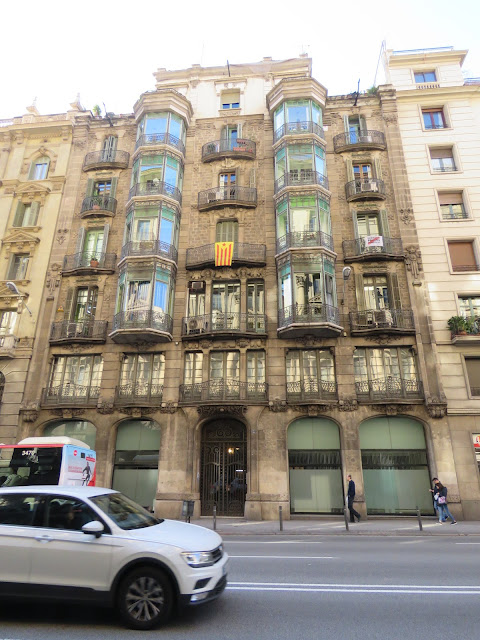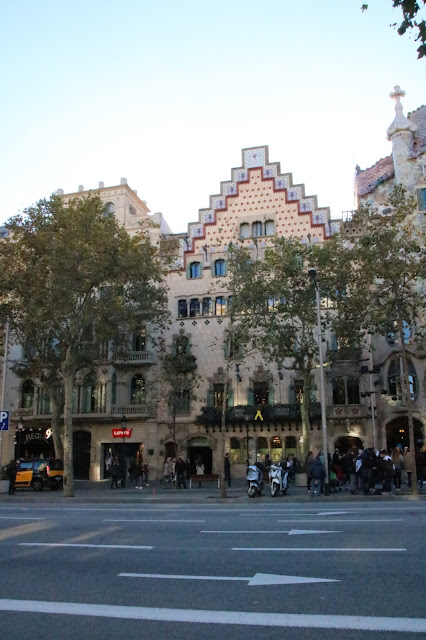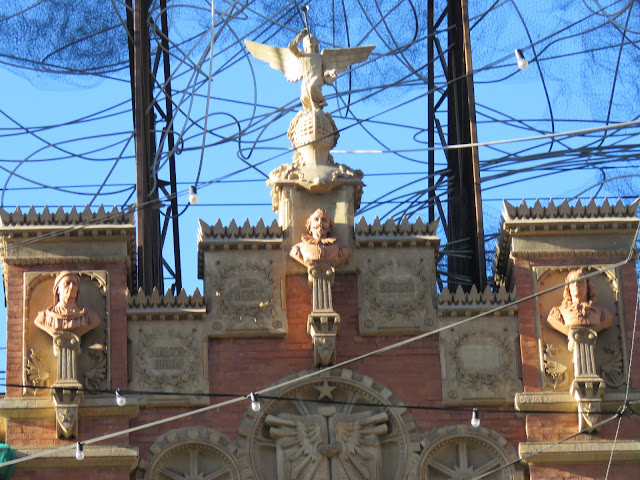Bid "adios" to Spain. Transfer to the airport for your departure flight
Meals: Breakfast
We have two more days!
We meet Anne and Bob for breakfast and say goodbye to the others. It is Anne and Bob's last day so we head out at 9:45.
This map shows our wanderings but it doesn't include all our diversions for drinks, lunch, gelato and down various lanes.
The Estació del Nord or Estación del Norte, is a former main line railway station. Originally opened in 1862, it was closed as a railway station in 1972. It is now used partly as a bus station, partly as a large multi-purpose sports hall, and partly as a police station.
The Arc de Triomf (Catalan pronunciation: [ˈaɾk də tɾiˈomf]) or Arco de Triunfo in Spanish, is a triumphal arch. It was built by architect Josep Vilaseca i Casanovas as the main access gate for the 1888 Barcelona World Fair. The arch crosses over the wide central promenade of the Passeig de Lluís Companys, leading to the Ciutadella Park that now occupies the site of the world fair.
This bronze statue of Antoni Viladomat I Manalt by Catalan artist Torquat Tasso was one of a series eight monuments depicting Catalan heroes inaugurated in 1886. In 1959 most of the statues were melted down and used to make a replacement for the statue of Mare de Déu de la Mercè which tops the church of the same name. The only other statues which survived are the nearby statue of Roger de Llúria and the monument to Rafael Casanova.Antoni Viladomat i Manalt was one of the most important Catalan painters of the 18th century.
This bronze statue of Roger de Llúria was constructed in 1885 by Catalan artist Josep Reynés.
I
Parc de la Ciutadella is the largest, oldest, and most popular park in Barcelona.
Ironically, the 70-acre park used to be a fortress. After 1714, the Catalans were kept under control after they were defeated by the nationals. It was opened to the public for the 1888 Universal Exhibition. Today, it’s also a venue for city events and summer concerts.
Enter the park, and you’ll be on the main pedestrian avenue. On the right, you’ll see a fountain and a fence with three dragons on it.
In 1988 to celebrate the centenary of the 1888 World Exhibition, Barcelona born sculptor and painter Antoni Clavé constructed this massive modern sculpture in the Parc de la Ciutadella. Clavé formed a close friendship with fellow Catalan artist Pablo Picasso.
On July 16, 1879, a commission chaired by the industrial Ignacio Jaumandreu launched the project to make a monument to the memory of the writer and economist Bonaventura Carles Aribau (Barcelona, 1798-1862). The intention was to pay homage to the man who, with his poem, “Oda a la patria”, had been the driving force behind the Catalan Renaixença.
Behind it is Domenech's Castle of the Three Dragons, a modernist building built for the 1888 Exhibition. It has an medieval castle-like touches and was used as a cafe-restaurant.
The museum of zoology was constructed for the Exposición Universal de Barcelona (1888) by the architect Lluís Doménech i Montaner to serve as an exhibition. Most of the building is constructed of red brick. The most popular displays are the skeleton of a whale and exhibits dedicated for smaller children.
I had to duck into the Vespa rental place.
Museum of Chocolate or Museu de la Xocolata is a private museum owned by the Gremi de Pastisseria de Barcelona. The museum opened in 2000, at Carrer Comerç 36, in El Born, Ciutat Vella, on the ground level of an old barrack.
One of us really wanted to visit but was outvoted.
Across the street is a Vietnamese street food restaurant with an interesting parking sign and mural.
Selfies 3 euros.
Time for a little morning libation.
Souvenirs
Founded in 1881, El Rei de la Magia in Barcelona is one of the world’s oldest shops and museums specializing in magic.Somf of this will be new to the guys as they were so busy walking ahead of us and talking.
You will often find bronze plaques on Barcelona sidewalks honouring a long-established city business, such as this one.
Amazing architecture.
Lots of street art.
I have seen this called the Rocafort clock but other than a Youtube video I couldn't find anything else.
Stamped concrete tile designs are very commonly used in central areas of Barcelona which features interlocking circles surrounded by a square.
Across the street is a Vietnamese street food restaurant with an interesting parking sign and mural.
Selfies 3 euros.
Time for a little morning libation.
Souvenirs
Founded in 1881, El Rei de la Magia in Barcelona is one of the world’s oldest shops and museums specializing in magic.Somf of this will be new to the guys as they were so busy walking ahead of us and talking.
Amazing architecture.
Lots of street art.
I have seen this called the Rocafort clock but other than a Youtube video I couldn't find anything else.
Stamped concrete tile designs are very commonly used in central areas of Barcelona which features interlocking circles surrounded by a square.
We were attracted by the roof on the Mercat Santa Caterina.
Santa Caterina Market was built in 1845 to provide the neighbourhood's blue-collar community with foodstuffs.
The spacious, modern market building was constructed on the former site of the Convent of Santa Caterina, from which it takes its name. During the post-Civil War period, Santa Caterina became the main food supplier to the towns on the outskirts of Barcelona. People from Sant Adrià, Santa Coloma and Mataró came on the tram to buy food in this market in times of shortage.
There were little kids dancing under these mannequins.
Now that's a fountain! It's wine.
Cuines Santa Caterina was our very lucky choice for lunch.
Cuines means kitchens in Catalan. Cuines with a S because this restaurant offers 4 different types of kitchens: Asian, Mediterranean, Italian and vegetarian…
Unisex bathrooms.
We're on the Gran Via and then Passeig de Gràcia is regarded as the most expensive street in Barcelona and in Spain. Formerly known as Camí de Jesús ("Jesus Road"), the Passeig de Gràcia was originally little more than a quasi-rural lane surrounded by gardens joining Barcelona and Gràcia, which was then still a separate town.
The Torre Glòries, formerly known as Torre Agbar (Catalan pronunciation: [ˈtorə əɡˈbaɾ]), is a 38-story skyscraper/tower located between Avinguda Diagonal and Carrer Badajoz, near Plaça de les Glòries Catalanes, which marks the gateway to the new technological district of Barcelona.
According to Jean Nouvel, Torre Agbar is intended to recall the shape of a geyser rising into the air. It was inspired by Montserrat, a mountain near Barcelona. In an interview, he described the tower as having a phallic character. As a result of its unusual shape, the building is known by several nicknames, such as el supositori("the suppository"), l'obús ("the shell") and some more scatological ones. It is also somewhat similar in shape to Sir Norman Foster's 30 St. Mary Axe in London, often called "the Gherkin".
Casa Batlló (Catalan pronunciation: [ˈkazə βəˈʎːo]) is a building in the center of Barcelona. It was designed by Antoni Gaudí, and is considered one of his masterpieces.
The house was bought by Josep Batlló in 1900. The design of the house made the home undesirable to buyers but the Batlló family decided to buy the place due to its centralized location.
In 1906 Josep Batlló still owned the home. The Batlló family was very well known in Barcelona for its contribution to the textile industry in the city. Josep wanted an architect that would design a house that was like no other and stood out as being audacious and creative. Both Josep and his wife were open to anything and they decided not to limit Gaudí. The family lived on the Noble Floor of Casa Batlló until the middle of the 1950s.
Casa Amatller (Catalan pronunciation: [ˈkazə əməˈʎːe]) is a building in the Modernisme style designed by Josep Puig i Cadafalch. Along with Casa Batlló and Casa Lleó-Morera, it makes up the three most important buildings in Barcelona's famous Illa de la Discòrdia ("Block of Discord"), noted for its unique modernist buildings.
Around the corner is the Fundació Antoni Tàpies (Catalan pronunciation: [fundəsiˈo ənˈtɔni ˈtapiəs], 'Antoni Tàpies Foundation') is a cultural center and museum, located in Carrer d'Aragó. It is dedicated mainly to the life and works of the painter Antoni Tàpies.
Antoni Tàpies i Puig, 1st Marquis of Tàpies 13 December 1923 – 6 February 2012) was a Spanish painter, sculptor and art theorist, who became one of the most famous European artists of his generation.
Constructed between 1880 and 1885, at an early stage of the evolution of Catalan Modernisme style, the building was the first in the Eixample district to integrate industrial typology, combining exposed brick and iron.
At this point we headed back to Las Ramblas in search of the gelato shop they had found.
WE passed through the Gothic district.
Els Quatre Gats "The Four Cats") is a café that famously became a popular meeting place for famous artists throughout the modernist period in Catalonia, known as Modernisme. The café opened on June 12, 1897 in the famous Casa Martí, and served as a hostel, bar and cabaret until it eventually became a central meeting point for Barcelona’s most prominent modernist figures, such as Pablo Picasso and Ramon Casas i Carbó. The bar closed due to financial difficulties in June 1903, but was reopened and eventually restored to its original condition in 1989.
The Palau de la Música Catalana (English: Palace of Catalan Music) is a concert hall is designed in the Catalan modernista style by the architect Lluís Domènech i Montaner, it was built between 1905 and 1908 for the Orfeó Català, a choral society founded in 1891 that was a leading force in the Catalan cultural movement that came to be known as the Renaixença (Catalan Rebirth). It was inaugurated February 9, 1908.
A giant cast-iron sculpture of Carmela created by Jaume Plensa in 2015.
One explanation that I found said “the building is designed around a central metal structure covered in glass, overflowing the building with natural light to make it into a magical music box which brings together all the decorative arts: sculpture, mosaic, stained glass and ironwork.”
We wandered into the lobby.
Across the Plaça de la Seu and opposite Barcelona's Cathedral, Picasso's frieze is on top of the modern Collegi d'Arquitectes building.
Lots of great little shops to poke.
The entryway of Espai Mescladís is jam-packed with people: neighbors, workers and visitors who come and go all day long, and waiters walking from the kitchen to the tables on the terrace. But there are also dozens of people staring out from black and white photos that cover the restaurant’s walls; some are alone, others in couples, families or groups, smiling and laughing.
Heading back to the hotel before an earlyish dinner as Anne and Bob are leaving in the morning.
The pastries in the bakeries are a killer!
An hour to put up our feet before we head out for our farewell dinner with them.
Xampu Xampu translates as Shampoo Shampoo!
Duck three ways.





















































































































If Gaudi's Sagrada Familia is not grotesque enough, Casa Batlló is perhaps worse. But what a lovely city Barcelona is.
ReplyDeleteTotally agree with your comment, Andrew. Barcelona is an extraordinary city. and four days was not enough to take it all in. must definitely go back.
DeleteIncredible architecture in the city!
ReplyDelete